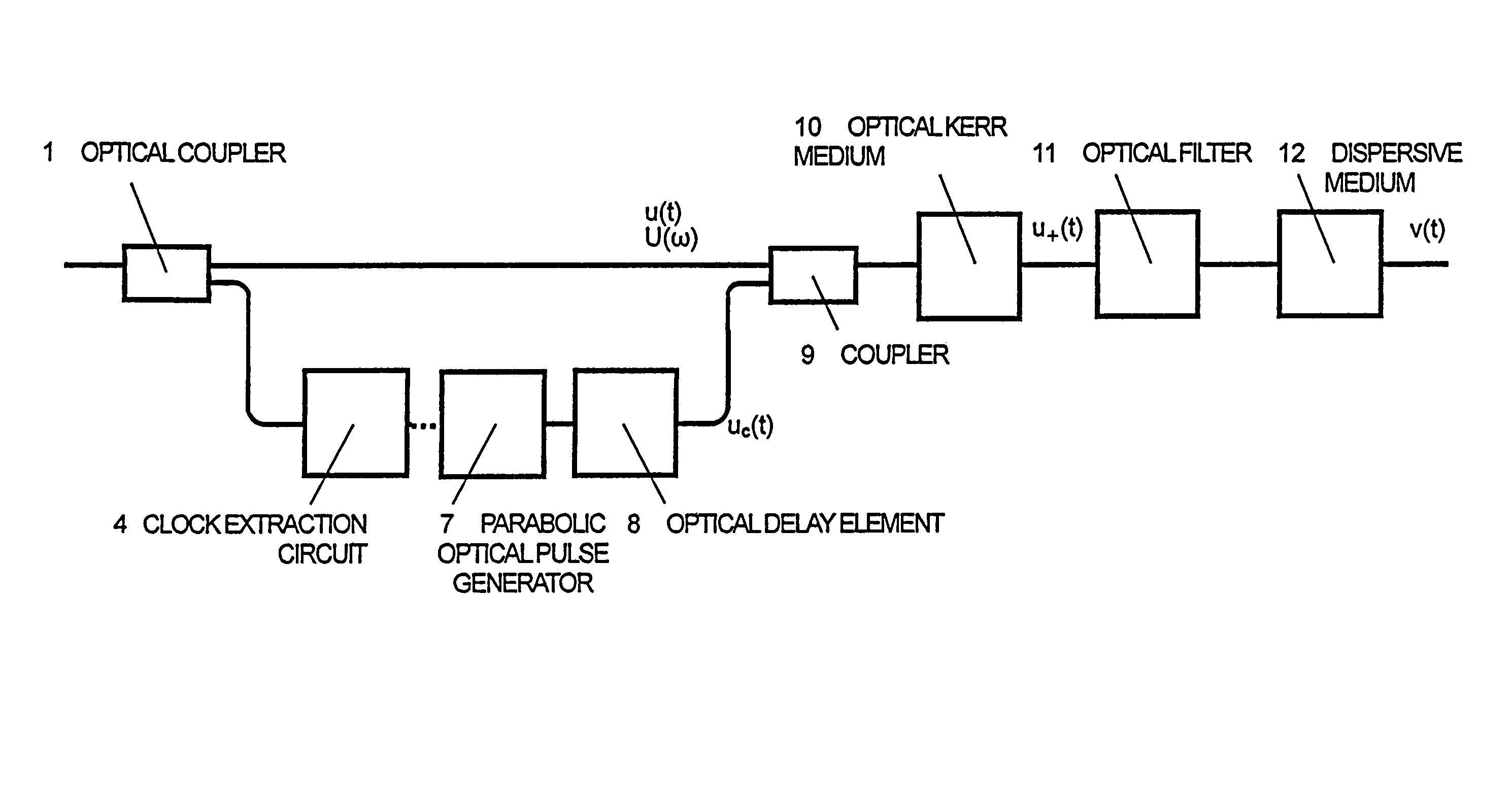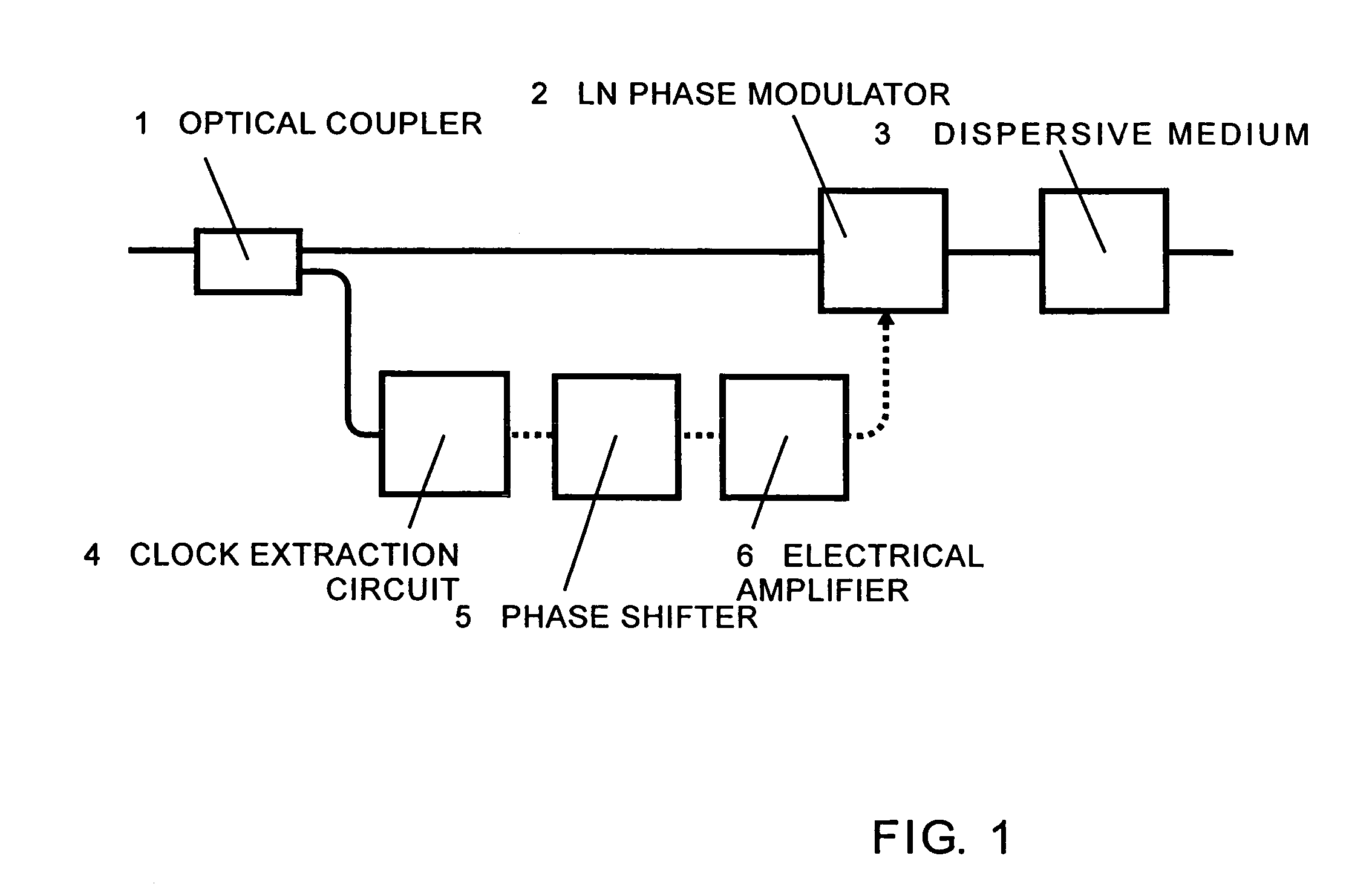Optical fourier transform device and method
a fourier transform and optical pulse technology, applied in the field of optical fourier transform devices and methods, can solve the problems of serious limitation of the available characteristic of optical fourier transform, the inability of the ln phase modulator used in conventional optical fourier transform to give a linear chirp uniformly, and the inability to accurately execute optical fourier transform to the optical pulse component in a range outside the window width, etc., to achieve accurate optical fourier transform
- Summary
- Abstract
- Description
- Claims
- Application Information
AI Technical Summary
Benefits of technology
Problems solved by technology
Method used
Image
Examples
first embodiment
A. First Embodiment
(Device Structure)
[0056]FIG. 3 is a structural view of an optical Fourier transform device of a first embodiment of the invention. The optical Fourier transform device includes an optical coupler 1, a clock extraction circuit 4, a parabolic optical pulse generator 7, an optical delay element 8, a coupler 9, an optical Kerr medium 10, an optical filter 11 and a dispersive medium 12.
[0057]The optical Kerr medium 10 is the medium having the third-order nonlinear refractive index, and for example, a single mode optical fiber, a photonic crystal fiber, a semiconductor optical amplifier, an erbium-doped optical fiber amplifier, an organic nonlinear material or the like is used.
[0058]As the dispersive medium 12, for example, a single mode optical fiber having a group-velocity dispersion characteristic in which a zero-dispersion region exists in the vicinity of a wavelength band of 1.3 μm, or a diffraction grating pair, a fiber Bragg grating or the like can be used. The c...
second embodiment
B. Second Embodiment
[0090]FIG. 11 is a structural view of an optical Fourier transform device of a second embodiment of the invention. A difference from the optical Fourier transform device of the first embodiment is that a dispersive medium 12 is positioned in front of a coupler 9 in this embodiment. Since the other structure is similar to the foregoing, its description will be omitted. Besides, a parabolic optical pulse generator 7 can have one of the structures of FIGS. 4 to 6 similarly to the first embodiment.
[0091]Next, the operation of the optical Fourier transform device of this embodiment will be described. In FIG. 11, a signal optical pulse (wavelength λs) having a temporal waveform u(t) and a frequency spectrum U(ω) and separated by an optical coupler 1 is first launched to the dispersive medium 12. A frequency spectrum U+(ω) of the signal optical pulse at the output of the dispersive medium 12 is given by
[0092] [Mathematicalformula12]U+(ω)=U(ω)exp(ⅈDω22)(11)
Next...
third embodiment
C. Third Embodiment
[0096]FIG. 12 is a structural view of an optical Fourier transform device of a third embodiment. The optical Fourier transform device of the third embodiment includes an optical coupler 1, a clock extraction circuit 4, a parabolic optical pulse generator 7, an optical delay element 8, a coupler 9, an optical Kerr medium 10, an optical filter 11, a dispersive medium 12, and optical circulators 20 and 20′. Since what are denoted by the same reference numerals as those of the optical Fourier transform device shown in FIG. 3 are similar to the foregoing, their description will be omitted.
[0097]In the figure, signal light separated by the optical coupler 1 is first launched to a port 20a of the optical circulator 20. The port 20a is connected to a port 20′a through a port 20b, the dispersive medium 12, and a port 20′b of the optical circulator 20′. The port 20′a and the port 20′c of the optical circulator 20′ are connected in a loop through the coupler 9, the optical K...
PUM
| Property | Measurement | Unit |
|---|---|---|
| refractive index | aaaaa | aaaaa |
| wavelength band | aaaaa | aaaaa |
| wavelength | aaaaa | aaaaa |
Abstract
Description
Claims
Application Information
 Login to View More
Login to View More - R&D
- Intellectual Property
- Life Sciences
- Materials
- Tech Scout
- Unparalleled Data Quality
- Higher Quality Content
- 60% Fewer Hallucinations
Browse by: Latest US Patents, China's latest patents, Technical Efficacy Thesaurus, Application Domain, Technology Topic, Popular Technical Reports.
© 2025 PatSnap. All rights reserved.Legal|Privacy policy|Modern Slavery Act Transparency Statement|Sitemap|About US| Contact US: help@patsnap.com



